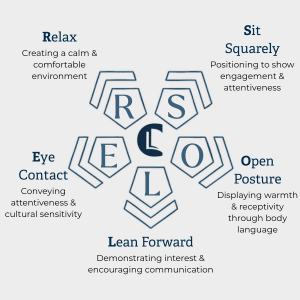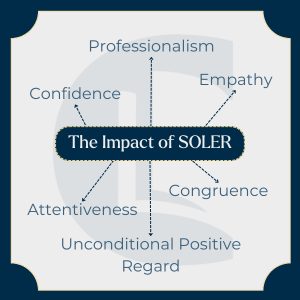Free Handout Download
Active Listening in Practice: Egan’s SOLER Model
Active listening is fundamental in counselling and psychotherapy. It allows practitioners to build strong therapeutic relationships and encourage client trust. Gerard Egan, a renowned psychologist, developed a structured approach to active listening known as the SOLER model. This method enhances the quality of therapist-client interactions and aligns with Carl Rogers’ core conditions of empathy, congruence, and unconditional positive regard.
By understanding and applying SOLER, therapists can improve their presence, attentiveness, and engagement, ensuring clients feel genuinely heard and understood. This article explores the SOLER model, its practical applications in therapy, and how it integrates into modern counselling practices.

Active Listening in Practice: Egan’s SOLER Model
By the end of this article, you will:
Gerard Egan’s SOLER model is just one aspect of his approach to helping people. In The Skilled Helper, Egan introduced a three-stage model that structures the counselling process around three key questions:
The SOLER framework is primarily used in the first stage, where it focuses on helping clients tell their stories, uncover blind spots, and prioritise issues. By ensuring attentiveness, openness, and engagement, SOLER enhances the therapist’s ability to listen actively and build a strong foundation for the rest of the counselling process.

Egan’s SOLER model provides a practical and structured approach to non-verbal communication in counselling. It ensures that therapists convey attentiveness and openness, making clients feel safe and valued.
SOLER stands for:

These elements play a vital role in non-verbal communication, helping the therapist establish rapport and deepen the therapeutic alliance.
While SOLER focuses on non-verbal communication, it is part of a broader set of attending skills essential for effective counselling. Other key skills include:
By combining SOLER with these skills, therapists create an environment where clients feel heard and guided, striking a balance between active listening and structured interaction.

First impressions matter in therapy. Egan emphasised that how therapists present themselves significantly impacts client trust and engagement. By consciously adopting SOLER, therapists project confidence, professionalism, and empathy, which are essential for a positive therapeutic outcome.
While Egan’s approach is sometimes considered directive, the SOLER model aligns well with Carl Rogers’ person-centred therapy. Non-verbal engagement through SOLER reinforces the therapist’s attentiveness, unconditional positive regard, and empathy, all key conditions in a person-centred approach.

Carl Rogers, the founder of person-centred therapy, focused more on the core conditions of empathy, congruence, and unconditional positive regard rather than structured counselling techniques. Rogers used very few explicit counselling skills, relying instead on deep presence and emotional attunement.
By contrast, Egan’s model introduces a more structured, skills-based approach, making it suitable for directive counselling techniques such as CBT and motivational interviewing. While SOLER aligns well with Rogers’ emphasis on attentiveness and presence, it adds a level of intentionality and strategy that some may argue is more structured than traditional person-centred methods.
Egan’s structured model fits naturally into directive approaches such as CBT and motivational interviewing. These therapies often involve goal-setting, structured questioning, and problem-solving, where active listening through SOLER ensures clarity and client collaboration.
While eye contact is a sign of engagement in Western cultures, it may be considered intrusive or disrespectful in some Asian and Indigenous cultures. Being mindful of cultural variations ensures that SOLER is adapted appropriately to each client’s background and comfort level.
Be mindful that eye contact may also be uncomfortable for some neurodivergent clients.

SOLER is widely used in counselling training to help students develop professional presence and active listening skills. Role-playing exercises incorporating SOLER help trainees internalise these behaviours, improving their ability to engage with clients effectively.

Some counselling professionals debate whether SOLER is too structured for non-directive approaches. Since it is based on clear physical cues and deliberate non-verbal techniques, some argue it moves away from the purely client-led approach championed by Carl Rogers.
However, Egan’s model has been widely adopted across various therapeutic disciplines, including healthcare, social work, and coaching, because it provides a practical and observable framework for engagement. While person-centred purists may prefer a more organic listening style, SOLER ensures consistency and professionalism, making it especially valuable in structured or time-limited counselling settings.
Active Listening in Practice: Egan’s SOLER Model
The SOLER acronym stands for Sit squarely, Open posture, Lean forward, Eye contact, Relax – each element describes a key non‑verbal behaviour that supports active listening in counselling.
By using SOLER behaviours the therapist projects presence, warmth and attentiveness, which helps clients feel heard, valued and safe – thereby deepening trust and the therapeutic alliance.
Yes – while SOLER supports person‑centred, CBT and motivational interviewing styles by improving non‑verbal engagement, practitioners must also adapt behaviours like eye‑contact and posture to respect different client cultures and comfort zones.
Gerard Egan’s SOLER model remains a cornerstone of active listening in counselling and psychotherapy. By adopting its principles, therapists can enhance their presence, strengthen therapeutic relationships, and facilitate deeper client engagement.
Incorporating SOLER into everyday practice encourages mindfulness in non-verbal communication, ensuring that clients feel heard, respected, and supported throughout their therapeutic journey.
By mastering SOLER, you refine your counselling skills and create an environment where clients feel genuinely valued and understood.
Egan, G. (1986). The Skilled Helper (3rd Ed.). Centage, Boston.
Counselling Tutor: Person-Centred Approach and Core Conditions
Counselling Tutor provides trusted resources for counselling students and qualified practitioners. Our expert-led articles, study guides, and CPD resources are designed to support your growth, confidence, and professional development.
👉 Meet the team behind Counselling Tutor
Notice any broken link or issues with this resource? Kindly let us know by email
Email us